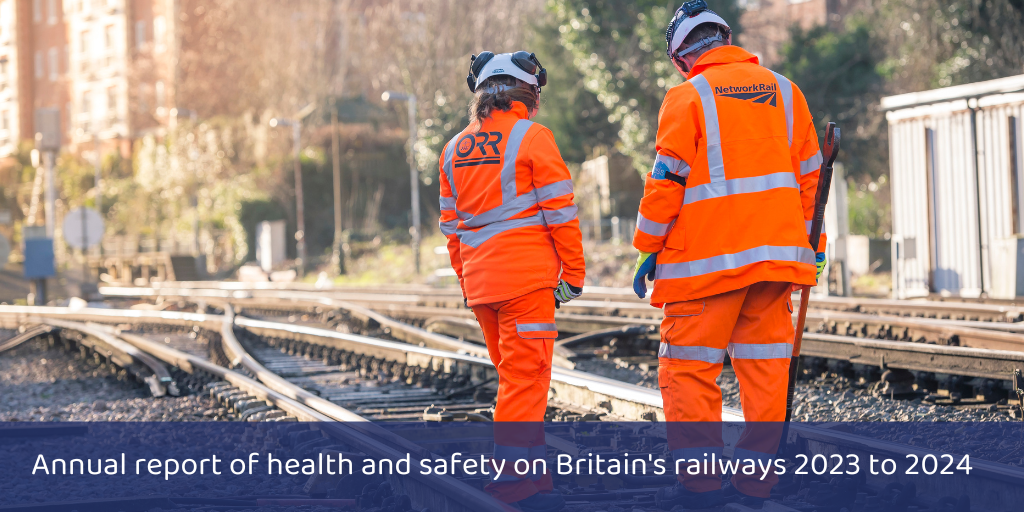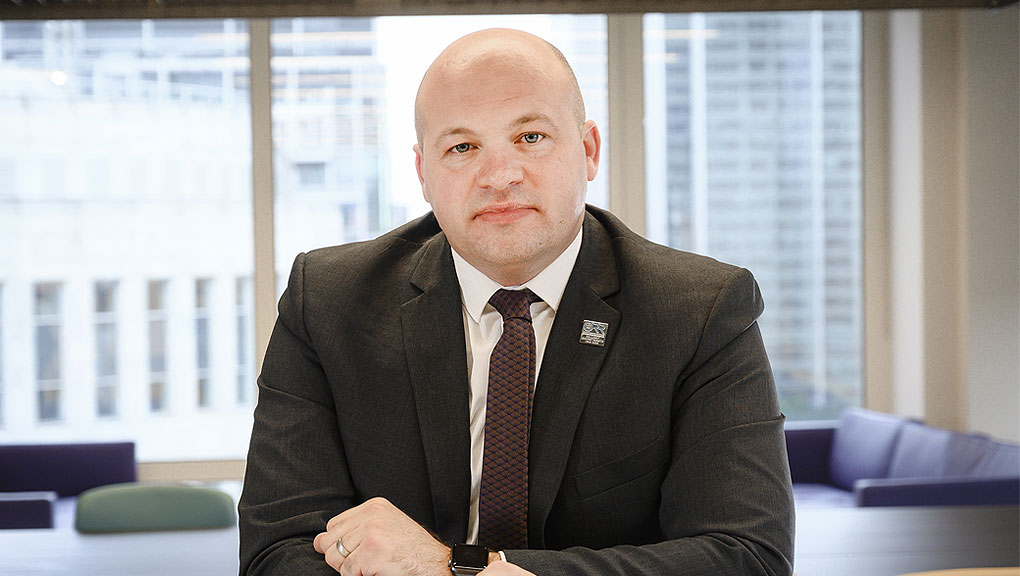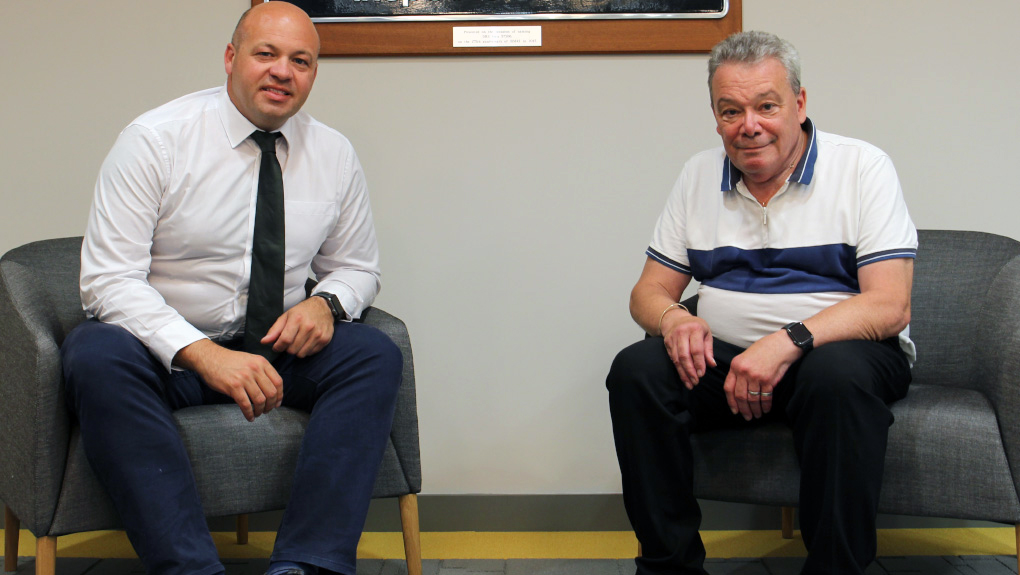
Chief Inspector’s review
by Richard Hines
HM Chief Inspector of Railways and Director of Railway Safety
 Great Britain’s railways continue be amongst the safest in the world. That statement is something that we should all rightly feel proud of. It’s an outcome that is the product of years of investment, strong leadership, a relentless focus on fixing important problems, increasing collaboration, and a collective commitment to ensure that lessons are learned and mistakes from the past are never repeated.
Great Britain’s railways continue be amongst the safest in the world. That statement is something that we should all rightly feel proud of. It’s an outcome that is the product of years of investment, strong leadership, a relentless focus on fixing important problems, increasing collaboration, and a collective commitment to ensure that lessons are learned and mistakes from the past are never repeated.
Our railways however face many significant challenges. The real impact that climate related changes are having on our infrastructure and operations are visible – this is not a problem for the future, but one we are facing now.
The industry also potentially faces a long period of significant change through further reform. In addition, it is operating in an environment where there is a greater reliance on maintaining existing assets rather than replacement. Put simply; this is not a time to be complacent.
The following sections of this report describe our assessment of the railway industry’s health and safety performance for the year. Based on feedback from last year’s report, we have again included a selection of case studies to illustrate how we have promoted, collaborated, and secured improved outcomes through our various interventions.
My key reflections from the last work year are briefly summarised below.
Network Rail
2023 to 2024 was an important year for Network Rail as it signalled the end of Control Period 6 (CP6), and the start of Control Period 7 (CP7). A detailed account of Network Rail’s performance against commitments over this four-year period is provided in our Network Rail Annual Assessment. But I do want to recognise the significant progress that has been made in a number of areas through CP6 which include trackworker safety, drainage asset inventories and occupational health improvements in areas such as Hand-Arm Vibration (HAVS). However, not all commitments were met in full and there is more to do to ensure that necessary improvements are implemented in a timely manner.
Network Rail maintained good health and safety performance during the year. It however continues to face challenges with managing asset safety in the face of weather-related risks, especially from extreme weather. Although still being implemented, Network Rail’s Modernising Maintenance reforms have the potential to deliver efficiencies but need to be done in a way that does not overload people with too much change too quickly, nor result in fatigue. An increased focus on occupational health risks is also required.
Mainline operators
We have seen improvements during the work year in the investigation of Signals Passed at Danger (SPADs) by dutyholders. However, the number of SPADs that were attributed to drivers increased during the year. Further work across the industry is required to understand what underpins this growing trend, and subsequently, what more can be done in the intervening period before the European Train Control System (ETCS), with speed supervision, is implemented more widely.
I have been very concerned to see recent instances where some Train Operating Companies (TOCs) have not implemented effective change management processes when modifying existing and introducing new train fleets. This, and an underlying apparent weakness in risk assessment capability, must be addressed.
Non-mainline railways
We continued to push for improved health and safety outcomes across our non-mainline railways portfolio which covers Trams, Transport for London, the heritage sector, the Channel Tunnel and Safety by Design.
Of particular note, we continued with our work to ensure that the Rail Accident Investigation Branch (RAIB) recommendations following the tragic Sandilands incident are fully implemented across the tram sector. We continue to support the good work of the Light Rail Safety and Standards Board (LRSSB) in driving improvements across the tram sector and entered into a new Memorandum of Understanding (MoU) with them to strengthen and formalise our relationship.
We also published new guidance to assist heritage rail operators with developing effective, but proportionate health and safety management systems. This formed the basis of six, in-person workshops we delivered across GB to 82 railways and tramways with the valuable support of the Heritage Railway Association (HRA).
Policy, strategy, and statutory permissioning activities
During the year, we continued to develop and improve our arrangements and supporting processes for regulating railway health and safety. We also delivered a range of statutory work through health and safety permissions and approvals.
In particular, we progressed recommendations from the post implementation review report of the Train Driving Licences and Certificates Regulations 2010 (TDLCR). We worked closely with the Department for Transport (DfT) to explore options for improving the efficiency of the licensing regime.
We continue to benefit from strong international relationships and collaboration. We were delighted to rejoin the National Safety Authority (NSA) Network as an observer following an invitation from the European Union Agency for Railways (ERA).
We maintain our approach of working closely with industry on regulatory issues. However, we will take enforcement action where necessary. We served nine enforcement notices during the year and concluded four criminal prosecutions which resulted in fines exceeding £14.5M.
Themes for the year ahead
The publication of our Annual Health and Safety Report provides an opportunity to set out what I consider to be the main themes and areas of challenge for the year ahead. I have three:
1. Delivering effective change, safely
At the time of writing this report the election was imminent and in due course we will find out if a future government intends to pursue rail reform. Further details will likely emerge over the coming weeks and months. As part of the Civil Service, we stand ready to work with all parties to support and assist the implementation of Government policy.
Reform may require enormous change. Change presents many opportunities, but also significant threats to effective health and safety management. There are many instances where ineffective change management processes, at every level, across every part of our industry, have been highlighted as a causal factor in major incidents. Poor change and project management also risks the efficiency and performance of the rail system. I’m asking the industry to ensure that mistakes from the past are not forgotten but are instead at the forefront of our minds and used as a test bed for new proposals. Maintaining corporate memory and having simple, effective, change management and supporting assurance processes will be essential.
I will ensure that my teams continue to be involved in transitioning towards any rail reform, providing advice on good health and safety principles, and that we do not allow planning and delivery of change to be a distraction from our crucial frontline activities. The industry must do the same.
2. Leadership, people, and capability
Given the pressures on the industry, there will need to be a firm focus on maintaining and improving the health, safety and welfare of the workforce, passengers, and public. This will require strong leaders to make timely and effective decisions. We cannot operate in an environment where there is inappropriate, unnecessary challenge and delay to addressing clear cut health and safety issues. Having the right capability, at the right level, in the right places, has never been more important.
After a long period of challenging industrial relations, the industry must continue to engage and collaborate with our Trade Unions on important health and safety issues. It is essential that we invest in our people and continue to break down barriers.
It is really important that a strong connection exists between those in senior, strategic decision-making roles and colleagues who work on the frontline. Nurturing an environment where there is a good level of visibility and understanding of what is actually happening on the ground is key to effectively delivering a high-performing, healthy, and safe railway.
We will focus on continuously improving our ways of working – with particular focus on activity planning, pace, and enforcement. This includes reviewing our regulatory approach to ensure we are strategic, effective, and transparent in all that we do.
3. Maintaining focus in challenging times
Given this challenging context and the very real potential for distraction it presents, it’s never been more important for the industry to ensure that there is a relentless focus on delivering a healthy and safe railway, every day, without fail. Having a good understanding of assets, their condition, how they behave in a changing environment, and maintaining them effectively, has never been more important.
The safe stewardship of our railways is a collective industry responsibility, and our industry is at its best when it harnesses the power of collaboration and comes together to fix important problems. Ensuring that the right issues are focussed on and striving for further improvements in management maturity across boundaries, will be key in this regard.
My team and I will be clear in articulating our priorities, and where necessary, taking robust action where we consider it’s required.
Our leadership and looking forward

Since our last Annual Report, our former Chief Inspector Ian Prosser CBE has retired after 16 years' dedicated service. Ian has achieved a huge amount in that time, and I want to formally recognise the positive impact his strong collaborative, ‘firm but fair’, regulatory approach has had across the industry. Thank you, Ian, for everything you have contributed. We are all very grateful and you will be missed.
To effectively deliver our regulatory functions, we rely on every part of the industry to play their part. I am grateful to the many individuals and organisations who have stepped up to make a difference, and where necessary, challenge others during the year.
Our people are our greatest assets – on that note, I’d like to thank my colleagues across the organisation for all that they do.
Finally, I expect this year to be a continuation of my transition into the Chief Inspector role. I will be looking for opportunities to evolve our approach and deliver ‘regulatory excellence’ in all that we do to achieve a healthier and safer railway in the most effective, efficient, and sustainable way possible.
Strong collaboration with all parts of the industry and being true to our values as an independent regulator will be key guiding principles on this journey. I look forward to working with you during the year ahead.

